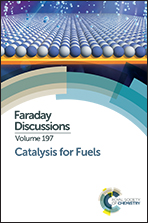Particulate photocatalyst sheets for Z-scheme water splitting: advantages over powder suspension and photoelectrochemical systems and future challenges
Abstract
Water splitting using semiconductor photocatalysts has been attracting growing interest as a means of solar energy based conversion of water to hydrogen, a clean and renewable fuel. Z-scheme photocatalytic water splitting based on the two-step excitation of an oxygen evolution photocatalyst (OEP) and a hydrogen evolution photocatalyst (HEP) is a promising approach toward the utilisation of visible light. In particular, a photocatalyst sheet system consisting of HEP and OEP particles embedded in a conductive layer has been recently proposed as a new means of obtaining efficient and scalable redox mediator-free Z-scheme solar water splitting. In this paper, we discuss the advantages and disadvantages of the photocatalyst sheet approach compared to conventional photocatalyst powder suspension and photoelectrochemical systems through an examination of the water splitting activity of Z-scheme systems based on SrTiO3:La,Rh as the HEP and BiVO4:Mo as the OEP. This photocatalyst sheet was found to split pure water much more efficiently than the powder suspension and photoelectrochemical systems, because the underlying metal layer efficiently transfers electrons from the OEP to the HEP. The photocatalyst sheet also outperformed a photoelectrochemical parallel cell during pure water splitting. The effects of H+/OH− concentration overpotentials and of the IR drop are reduced in the case of the photocatalyst sheet compared to photoelectrochemical systems, because the HEP and OEP are situated in close proximity to one another. Therefore, the photocatalyst sheet design is well-suited to efficient large-scale applications. Nevertheless, it is also noted that the photocatalytic activity of these sheets drops markedly with increasing background pressure because of reverse reactions involving molecular oxygen under illumination as well as delays in gas bubble desorption. It is shown that appropriate surface modifications allow the photocatalyst sheet to maintain its water splitting activity at elevated pressure. Accordingly, we conclude that the photocatalyst sheet system is a viable option for the realisation of efficient solar fuel production.
- This article is part of the themed collection: Catalysis for Fuels


 Please wait while we load your content...
Please wait while we load your content...